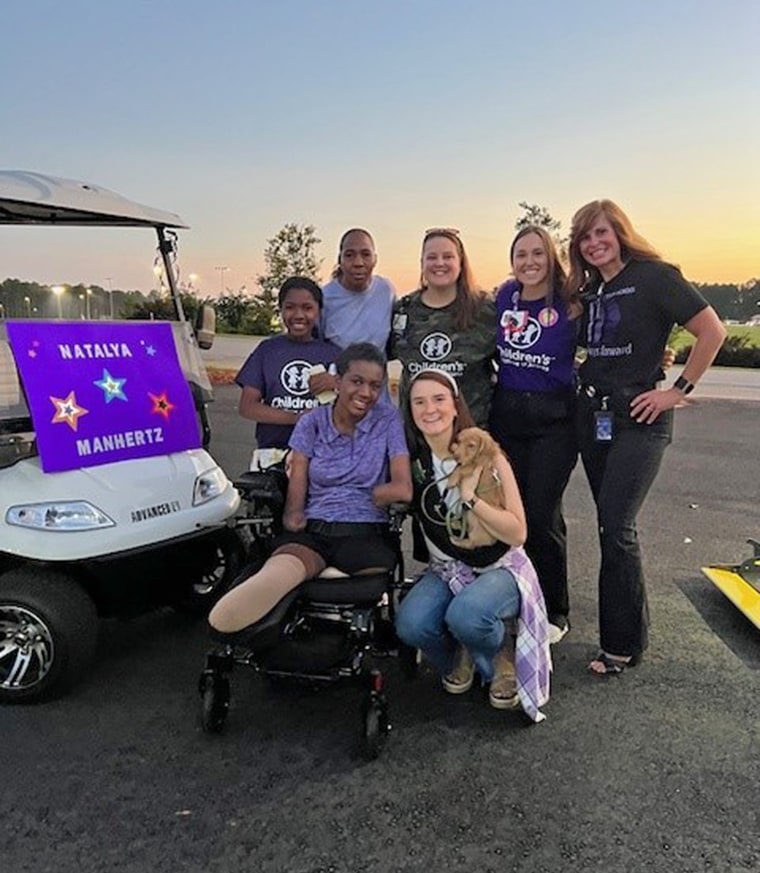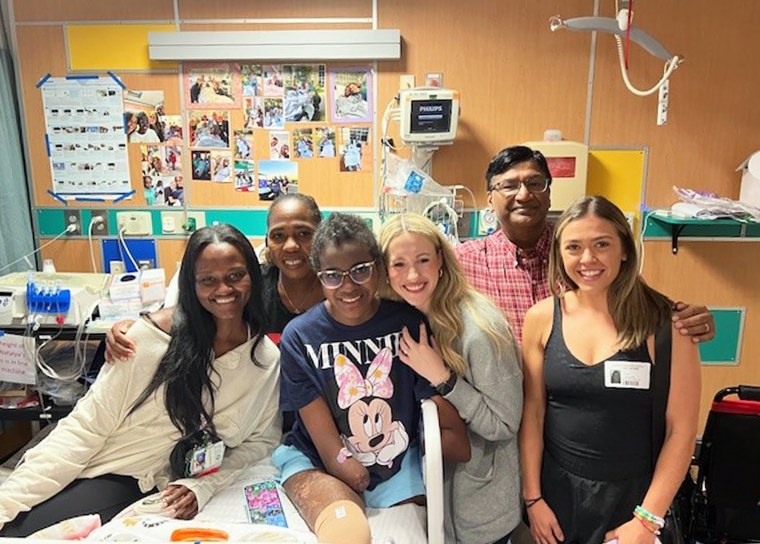Last May, Natalya "Nat" Manhertz began experiencing neck pain, stomach pain and a headache. Her mom, Thelia Manhertz, took her to urgent care, where they gave Nat Manhertz medication for a migraine. But her condition worsened, and they then went to the emergency room.
Nat Manhertz was diagnosed with strep throat, but continued deteriorating. The family eventually learned that she had sepsis, when the body's reaction to an infection turns life-threatening.
“She started suffering from organ failure,” Thelia Manhertz, of the Peacetree City, Georgia, tells TODAY.com. “The doctor came to me and says, ‘She’s had cardiac arrest.’”

After grappling with sepsis, Nat Manhertz eventually had to have all four limbs amputated. While she’s “still processing” her experience, she knows the care she received saved her life.
“I wasn’t like sad or mad or happy, I was just like ‘Wow,’” Nat Manhertz, 18, tells TODAY.com. “It had to be done and I came to the conclusion it’s either amputation or dying and I’m thankful that God spared my life.”
‘Everything hurt’
On Sunday in May 2023, Nat Manhertz started off having a fever and sore throat, so she took a sick day from school on Monday. She felt a little better and went to school on Tuesday. Almost immediately upon arriving, her symptoms intensified.
“I felt like I was about to pass out,” Nat Manhertz says. “I (was) not able to try to drive home.”
Her mom picked her up, and she tried napping when she got home.
“I was in constant, aching pain. Everything hurt,” she recalls.
After experiencing stomach and neck pain with a headache, Nat Manhertz visited urgent care, where doctors told her she had a migraine. They prescribed medication, but it did little to ease her pain. She woke from a nap feeling extremely uncomfortable.
“She was like, ‘I’ve never felt this pain before,’” Thelia Manhertz recalls.
Thelia Manhertz took her daughter to the emergency room, where doctors ran tests and diagnosed Nat Manhertz with strep throat. But they also learned something shocking: Nat Manhertz’s organs were failing. Doctors transferred the teen to Children’s Health Care of Atlanta by flight. When her mom arrived, doctors said her daughter was in serious condition and had experienced cardiac arrest.
“(They said) she’s going into septic shock. I’m like, ‘What is that?’” Thelia Manhertz says. “They’re like, ‘We have to get her onto some ... machine immediately to save her life.’”
Thelia Manhertz felt stunned by the rapid progression of her daughter’s illness.
‘It’s like, ‘Wow, how do we get from here to there?’” she says.
After about a week, doctors weaned Nat Manhertz off the ECMO machine, which helps the heart and lungs function when a person is seriously injured. She still needed a breathing tube and received sedation as she recovered. When she became more aware in the middle of June, she looked down at her hands and felt stunned.
“I look at my nails specifically. I remember I (asked) my mom, ‘Why are my hands black and where are my nails?’” she says. “My legs were even worse.”

As Nat Manhertz battled sepsis, the capillaries in her limbs didn’t work properly, causing her tissues to die. Her skin sloughed off and smelled like fish, she says, and undergoing bandage changes felt excruciating.
“My hands were just like hard rocks. I couldn’t move them,” she recalls. “I came to the acceptance mentally that this is not getting any better. This is gross. Go ahead and take them off because I don’t want them anymore.”
Sepsis and septic shock
Sepsis is a serious condition that normally occurs after someone experiences a bacterial infection, though viral infections can also cause it.
“Sepsis is essential when you get a bloodstream infection,” Dr. Lisa Lima, an assistant professor of pediatrics in the department of critical care at Children’s Healthcare of Atlanta, tells TODAY.com. “Usually, you have a preceding infection, and then your body kind of goes haywire trying to fight that infection off.”
As the body works to heal itself, other problems can occur.
“Your body’s fight against that infection actually ends up causing some of the damage,” Lima says.
Doctors remain unsure why Nat Manhertz’s strep throat developed into sepsis but believe it is possible that she had a cut in her throat that allowed the bacteria to enter the blood stream. Much about sepsis remains a mystery to experts. Luckily, sepsis remains uncommon.
“Most kids are going to go through having strep throat, getting a scrape on their knee, having the flu without ever having any subsequent problems,” Lima says. “In the grand scheme of things, it’s pretty rare.”
Lima says doctors treat sepsis with antibiotics and fluids and also help to stabilize blood pressure. If blood pressure dips too low, the condition becomes severe.
“You enter into septic shock when you start to have problems with your blood pressure,” she says. “Potentially you start to have evidence of what they call end organ dysfunction — so if your kidneys aren’t working as well, or if you’re starting to have evidence of liver injury (or) sometimes the heart.”
Nat Manhertz’s blood pressure “became incredibly low,” and she was struggling so her medical team placed her on ECMO for about a week to help, Lima says.
“She was on the type of ECMO that supported her heart and her lungs until her body was able to really repair itself and get her to the point where she didn’t need that support anymore,” Lima explains.
While the arteries and veins in her body were healthy, her distant capillary beds in the limbs failed to work properly, and her arms and legs didn’t receive enough blood flow.
“If you’re not getting adequate blood flow to those tissues, those tissues eventually slowly start to die off,” Lima says. “Your body starts to prune off areas where it’s not getting good blood flow.”

Doctors removed her arms about mid-forearm and one leg is amputated slightly above the knee and the other was amputated slightly below the knee. While many teens would feel overwhelmed with needing to undergo so many amputations, Nat Manhertz had a healthy outlook on it.
“She didn’t want things to hold her back,” Lima says. “She already had a journey planned out in front of her and was going to do it no matter what, … She’s a very strong girl and very mature for her age.”
'Trying to find the beauty'
Nat Manhertz has faced some complications since undergoing a quadruple amputation, such as phantom limb pain in her legs.
“It felt really weird at first because I feel my legs, but I know they’re not there,” she says. “They started to hurt.”
Dr. Vipin Bansal, a pediatric anesthesiologist at Children’s Healthcare of Atlanta, focuses on pain management, and understands the importance of treating phantom limb pain.
“It’s something that happens after amputation, and it’s where people still think they have an arm or leg that’s still hurting,” Bansal tells TODAY.com. “It does happen quite often unfortunately with amputations. ... If we get involved early on, we can help.”
He knew that nerve stimulators have worked in adults to ease phantom limb pain, and he suspected it could also help Nat Manhertz with her pain. He implanted a device next to a nerve for 60 days hoping to relieve some of the sensations she felt.
“It’s basically scrambling the pain signals to the brain to make sure everything seems OK,” he explains.
The nerve stimulator worked so well that Nat Manhertz no longer uses medication.
“She’s not having pain,” Bansal says. “That’s the miracle really for me.”
Nat Manhertz agrees. Thanks to the care she received, she returned to high school and is on track to graduate. She hopes to be a sports broadcaster and is still looking at colleges. Currently, she’s waiting for her prosthetic devices to be completed and feels excited to use them. The support of her family and friends, as well as her faith in God, has helped her throughout her illness and adjusting to life as a quadruple amputee.
“It’s not easy at all. Some days were really hard and just really painful. … I’m still learning,” she says. “I’m trying to find the beauty. I am who I am, but I am still trying to adjust to how I look.”